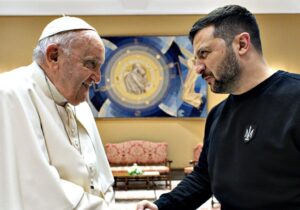The decision to use the atomic bomb against Japan at the end of the Second World War remains one of the most controversial issues in American history. I have argued in numerous places (for instance here, here, here, and (with Bill Miscamble) here) that the bombing of Hiroshima (and subsequently Nagasaki) was not only morally permissible, but, given the context of the times and the actually available options, morally obligatory. This is taking things a bit further than sometimes—even most times—done. While some Christian thinkers have agreed with the assessment that the bombing was the right thing to do, they tend to frame it as a matter of having to choose the lesser of a bevy of greatly evil alternatives. In response to this and similar claims, I am finishing up (and have been for some time) a book-length defense of the bombing on just war grounds. My long-gestated assertion is that dropping the bomb was not a lesser evil. It was, in the horrible milieu of the Asia-Pacific in 1945 in which the intransigence of Japan’s militaristic leaders forced choices between conflicting moral duties, the greatest possible good that could have been done because it presented the most discriminate and proportionate available chance to end the war through the unconditional surrender of Japan in the quickest possible time. I will leave begging, here, a great number of assertions that require defending. Suffice it to say, the decision to drop the bomb did not render American leadership guilty of moral wrongdoing, because they didn’t do anything wrong.
Not everyone thinks so. In a recent piece in Foreign Affairs, Adam Mount, a nuclear strategy thinker and senior fellow at the Federation of American Scientists, argues that during President Biden’s recent trip to Hiroshima, Japan to meet with G-7 leaders, the president fumbled an opportunity to atone for American sins there and in Nagasaki.
If you’re wondering what precisely America has to atone for in ending the Asia-Pacific War, it’s probably because you’ve not imbibed, pace Mount, the historical Kool-Aid. Throughout the essay, Mount has centered in his crosshairs what he takes to be the traditional narrative regarding why the United States bombed Hiroshima and Nagasaki: U.S. officials were forced to drop the bombs in order to end the war, to avoid a devastating invasion, and to save the lives of both U.S. warfighters and Japanese civilians. He clearly doesn’t believe this. Rather, he contends that the traditional narrative is fueled by “lies, censorship, and racism.” To defend his polemic, Mount grounds assertions in a series of overly simplistic historical claims, generally eliding complicating facts, factors, and counterarguments that would upset his own polemic.
It is a widely canvassing essay and there is a lot to push back against. I’ll limit myself to what I take to be Mount’s central complaint. Against the traditional view that the bombings were done to minimize civilian casualties, Mount asserts that “the bombings of Hiroshima and Nagasaki were a deliberate act of government policy to kill civilians.” As such, he notes, what occurred on the 6th and 9th of August in Japan, in 1945, was a crime. The crime was murder. Indeed, he further suggests, what occurred was close to being a crime against humanity.
The case begins, at least, circumstantially. Mount is quite exercised about precisely where Little Boy and Fat Man landed. Regarding Little Boy, he notes that the aiming point of the Hiroshima attack was inconsistent with claims that Little Boy was targeting military assets. He rightly observes that the bombardier in the Enola Gay aimed for the Aioi Bridge, a distinctive landmark in the center of Hiroshima. He believes this is significant. So too the fact that Nagasaki was not the primary target on August 9th. Kokura, which had significant military targets was supposed to be Fat Man’s objective. Kokura, however, dodged, to be ludicrously inexact, a bullet. The weather over the city had suddenly changed and by the time the bombing team in Bockscar had reached the city it was obscured in clouds or smoke. After circling for some time hoping for a clear view of the target–well beyond prescribed safety limits in fact–the flight crew was beginning to run low on fuel and finally accepted the need to turn back. Nagasaki, the secondary target, was on the return route. Bockscar had to circle Nagasaki several times as she too was encased in clouds. In the last possible moment, however, a break appeared in the clouds and, as we well know, the bombardier was albe to release his weapon. While there is some contention as to exactly what the aiming point in Nagasaki was, it seems generally accepted that Fat Man hit up to three quarters of a mile off target, detonating over a residential area and destroying among much else a host of hospitals and medical facilities, houses of worship, schools, and homes.
From all this Mounts takes as it a given that if Hiroshima’s airfield, ordinance depots, heavy industry, and navy units clustered around her port were the true targets, then Little Boy would have been released some two miles south of its actual aiming point. As it was, these military assets were only modestly damaged. Neither the blast nor the fires reached them, leaving in doubt the degree to which, if at all, their destruction was ever deemed essential. The attack on Nagasaki, meanwhile, appears to Mount to have been far too cavalier. Mount, I think, is doubtful whether the bombardier really had any reliable visual on the intended target at all. He barely hints that it might be more likely, instead, that they simply did not want to waste the bomb by dumping it into the ocean before attempting to make their way home. Taken together, Mount finds the planning for the use of the atomic bombs against military targets, from the highest levels downward, “cursory and careless.”
The best explanation, he asserts, is that military targets were never really the primary aim. Instead, “killing large numbers of civilians was the primary purpose of the attack.” He goes on to cite documentary records that show that U.S. officials hoped that the destruction of civilians would shock the Japanese leadership into surrender. Exhibit A in this claim is the minutes from the third meeting of the U.S. Targeting Committee—the presidentially appointed team that, as its name implies, helped determine where the bombs would be used. In this third meeting, the Committee recommended a set of release guidelines, mandating that no attempt should be made to drop the bomb on isolated industrial targets but rather in the “center of [the ] selected city.”
How do we assess this? It’s certainly true that the Targeting Committee made such recommendations. More precisely, the language they used requested that bombing crews “should avoid trying to pinpoint” military or industrial installations because they were “small, spread on fringes of cities, and quite dispersed.” These more precise details are helpful in understanding intent.
We need to understand that the aircraft releasing the atomic bombs had to do so from tremendous heights—approximately 30,000 feet—in order to escape the shock wave and avoid the radioactive cloud that would follow the bomb’s detonation. Small, isolated industrial targets were simply impractical—they couldn’t be easily located at such an altitude. The center of large urban areas—especially when marked by easily identified landmarks like, in Hiroshima, the T-shaped Aioi Bridge, could be more reliably spotted from the air. Turning to the attack on Nagasaki, while it might have seemed haphazard, it’s important to understand that the prospect of not dropping the bomb carried significant implications for the flight crew. As Mount noted, Bockscar’s crew would likely have had to drop the bomb in the ocean rather than attempt to return all the way home with it. The loss might have been catastrophic. Strategically, Little Boy and Fat Man constituted a kind of one-two punch. Little Boy made the Japanese leadership realize that America had succeeded in developing an atomic bomb. Fat Man, released a mere three days after the first bomb, was intended to make plain that we had more than one. If we lost Fat Man, another bomb would not have been ready for almost a fortnight. The delay might have suggested parsimony and given the Japanese reason to conjecture that America did not have a ready supply of atomic weapons. Moreover, as already suggested, Bockscar could not have simply carried the bomb back to base. Among the numerous possible problems, landing with the unexploded atomic bomb–even if diffused– posed unknown hazards and no one wanted to test whether Fat Man was susceptible to the shock of a bumpy touchdown. In any case, the crew wouldn’t have made it back with the bomb had they tried. As it was, even without the fuel-draining weight of Fat Man, Bockscar failed to make it back to Tinian and, instead, had to make Okinawa, which it barely did, for an emergency landing. On final approach, one engine failed from fuel starvation and a second died just as she touched down.
It must also be said, without overstating it, that the military status of both Hiroshima and Nagasaki is incontrovertible. While neither, of course, was a purely military target, each had important assets that were appropriate to knock out. Hiroshima, among much else, was home to the Japanese Second Army, which, not incidentally, was responsible for coordinating Ketsu-go–the decisive final defense of Japan–which included overseeing the defense of southern Japan and the allied landing beaches on Kyushu. The headquarters was destroyed in the blast. Fat Man, however off-target it was, destroyed the two primary military industrial installations in Nagasaki.
That said, it’s true, I would agree, that the military status of the target cities was somewhat secondary. The Target Committee had rather bigger fish to fry. The primary criteria for the target cities was that they were essentially untouched by conventional bombing attacks. It was crucial that the power of the bomb be fully displayed in order to rattle a Japanese leadership hellbent on forcing a final ground confrontation on Japanese soil. Intact cities, full of intact structures that could all be knocked down, was the most likely means to demonstrate just how powerful the bombs were. This is also why the center of the cities were the aiming points. To aim at isolated targets on the fringe of the cities would leave much of the city untouched. If the bombs were intended to shock the Japanese leadership into recognizing that there would be no need for the Allies to launch a land invasion, then shocked they must be. Partial destruction would be insufficient. The hope was that the power of the blasts would render obsolete the idea in the mind of the Japanese authorities that they could fight a final battle so bloody that the Allies would agree to negotiate surrender terms more beneficial to Japan.
Thus, I assert that civilians were not, in fact, the direct targets in the attacks on Hiroshima and Nagasaki. Rather, the directly intended targets in the attacks on Hiroshima and Nagasaki were Hiroshima and Nagasaki. The true object of attack were the cities themselves.
This is more than semantics. The intent–the desire with which American leadership united their will–was never to kill as many civilians as could be killed, nor, simply, to kill “large numbers” of them as an end in itself. We know this in part because of the character of the target list. Of the several cities on the original prospective list, two cities, Yokohama and Kyoto, didn’t make the cut to the final list. It should be noted that both cities had significantly greater populations than the four cities–Hiroshima, Kokura, Nagasaki, and Niigata–that did make the list. Yokohama was taken off, in all likelihood, because by August it had been already been heavily damaged in a conventional attack. With over 40% of its cities turned to rubble in that raid, it was no longer a good candidate for demonstrating the power of a single atomic bomb. Kyoto, a spiritual and intellectual center, on the other hand, benefiting from American hesitance to harm a city of such cultural significance, had remained largely untouched by conventional bombs. It’s an odd thing, surely, if our primary ambition was killing large numbers of civilians, to ignore populous cities simply because one is busted up and the other is culturally sensitive. Moreover, while Hiroshima was indeed the most populous city of the four remaining on the list, it’s by no means clear that this fact determined her first-target status among the final four. Hiroshima was also the best candidate for demonstrating the bomb’s power due to its size, construction, and the presence of low hills on either side of her that would serve as buffers to help contain and concentrate the blast. Lastly on this point, recall that on August 9th Kokura was supposed to be the primary target, not Nagasaki. This despite Kokura having a smaller population than Nagasaki. Again, such a fact complicates–puts to bed really–the idea that mass slaughter was ever the primary concern. Indeed, when one reads the memoirs or biographies of some of the men behind the bombs and the use of the bombs, we get the indication that the death of Japanese civilians was never intended for its own sake, nor as an end in itself.
None of this makes the death of civilians easy to bear. However indirect, the fact that civilians would be killed in large numbers in any of the targeted cities ought to have weighed heavily on the planners. If effective and equally viable alternatives could be found, then they should have been grasped. But they could not be found. They did not exist. Japanese intransigence guaranteed this. Mount laments, rightly, that we will never know just how many died in the two cities that we reduced to rubble knowing they would die. In exploring the grim tally, he gives the contrary estimates offered by American officials and contemporary Japanese researchers, both the low and the high. Each are ghastly enough. He also tends to isolate attention to the number of dead children. He notes too the inability of the bomb to make any kind of differentiation whatsoever, as seen in the array of non-Japanese killed: the possibly tens of thousands of Koreans, most forcibly transported from their homes to Japan to be interred and utilized in forced labor camps; the Javanese, Dutch, British, Australian, American, and other prisoners of war. It is right and just that he does all this.
Another point of potentially strong agreement I have with Mount is his assertion that even if we believe the traditional narrative about why the U.S. destroyed Hiroshima and Nagasaki or–I would add–whatever the reason we support the atomic bombings, we nevertheless “should regret that the bombs killed children, doctors, teachers, religious leaders, Allied prisoners of war, and forced laborers.” We should regret that. And I do.
But I also regret that elsewhere throughout the Asia-Pacific War other children, doctors, teachers, religious leaders, Allied prisoners of war, and forced laborers–all under Japanese occupation–were also killed. So, while Mount does well to count the dead, he would do better to count all the dead.
It is almost a truism to point out that innocent people were dying all across the Asia-Pacific in the late summer of 1945. Some of these innocent were in Hiroshima and Nagasaki. Most of the innocent dead and dying were prisoners in their own lands, held captive under Japanese occupation. The numbers are staggering. By late 1944 and throughout 1945, reliable estimates suggest that the number of innocent civilians and noncombatant POWs who died in Japanese hands totaled upwards of 200,000—250,000 souls per month, or somewhere in the vicinity of 8,000 lives per day. Some reliable sources insists this is a lowball estimate.
Whatever the number, the ghastly toll can be placed at the feet of one nation. The Asia-Pacific War was launched, and prosecuted, by a nation whose highest ideals had become, in historian John Lewis’ words, “violently hostile to human life.” Key Allied decision-makers at that time would have known this. Various entities, including the U.S. ambassador in Chungking, British and American military commanders in theatre, and the Office of Strategic Service teams in China, Thailand, and Indochina kept Washington informed about the suffering of Asia. Werner Gruhl summarizes the macabre accounting:
By August 1945 the Allies in the Far East and Pacific had paid a price for the long years of resistance to aggression that is incomprehensible to most of us today. In this vast geographic crucible, some 20 million innocent Allied civilian lives, of whom at least three million were children, were snuffed out by the war. Another estimated 85 million civilians or more suffered forced labor and refugee ordeals, malnutrition and disease, wounding, maiming, rape, and torture; internment hell, war orphan and widow anguish, and Japanese supported opium addiction.
The death toll among civilians in Japan was also terrible, without question. But scope is important. Japanese noncombatant deaths may have reached, at the upper limit, about 1.2 million. A rough calculation, then, tells us that for every Japanese noncombatant death some 17 or 18 noncombatants from other Asian nations died—12 of them would have been Chinese—by Japanese hands. Every day in 1945, Japan’s military controlled the destiny of the Far East and could have brought this suffering to an early end with a simple word. But every day that Japan refused to acknowledge its own defeat, and to allow knowledge of defeat to result in surrender, was another day that thousands of noncombatant deaths were added to the butcher’s bill generated by their intransigence.
Lingering for a moment on this last group of innocent people who were dying in the Asia-Pacific–Japanese civilians themselves–is also fruitful. Japan, of course, while they doled out staggering amounts of death, sustained death as well. When the Soviets overran Manchuria and other areas on the Asian continent, they captured around 2.7 million Japanese, about two-thirds of whom were civilians. Between 340,000-370,000 disappeared in Soviet captivity forever. In the homeland itself, Gruhl estimates that by the end of the summer of 1945, upwards of 50,000 Japanese died each week. As a cluster of innocent people, the Japanese civilian population was also, if abstractly, in conflict with itself. What I mean is this: there were only so many scenarios by which the war was going to end. Different amounts of Japanese civilians were going to die in each scenario. It is instructive to compare those numbers. For instance, under the blockade and bombardment campaign, Japanese were presently being killed by the relentless American bombing runs and the violence and deprivations that these caused. But as the casualty estimates for the proposed land invasion continued to mount, interest began to increase for simply tightening the blockade and keeping Japan under siege until she succumbed. The cruelty of this strategy would have been mindboggling. It would have resulted in millions of starvation deaths, especially as the Japanese rice crop would fail early in the new year. By the same token, had American planners stuck with the invasion plan, then the numbers of Japanese civilian death–while likely less than in a blockade–would certainly have far exceeded the deaths due to the atomic bombs, especially given the universal conscription orders and the shocking willingness among the Japanese–as we learned on Saipan and Okinawa–to die rather than give in. In the macabre world the Japanese made, one can conjecture across time and space the existence of various clusters of innocent Japanese civilians whose interests were in competition with one another. It was the Japanese leadership who determined that some one cluster of its innocent civilians or another would die before the war ended. The only thing the Americans could do was to limit that death as much as their available options made possible.
The point is this. For every day that the war continued, thousands upon thousands of innocent civilians died throughout the Asia-Pacific. Every day that Japanese leadership continued to gamble on a decisive final fight, their intransigence was measured in the heaping mounds of the innocent dead. The tragic reality is that there were clusters of innocent lives scattered across the Pacific and not all of them could live. Every decision, every action or inaction, would doom one or another of them. To act to save any one group consigned some other group to oblivion. Given the terms in the Asia-Pacific at the time, we had cause to prefer the competing clusters of innocent lives over the innocent souls in Hiroshima and Nagasaki.
If Mount’s thing is the saving of innocent lives, he should be in support of the dropping of the bombs. And he should continue to regret the necessity of it. But regret does not necessarily signal wrong. Just as grief does not necessarily signal guilt.
Parts of this essay come from Moral Horror: A Just War Defense of the Bombing of Hiroshima, currently under review, and early drafts of the chapter “Military Necessity As Moral Imperative: Just War and Hiroshima” from Returning Military Necessity to Just War Statecraft, co-edited by Marc LiVecche and Eric Patterson, forthcoming from Routledge.







 Sponsor a student for Christianity & National Security 2024
Sponsor a student for Christianity & National Security 2024